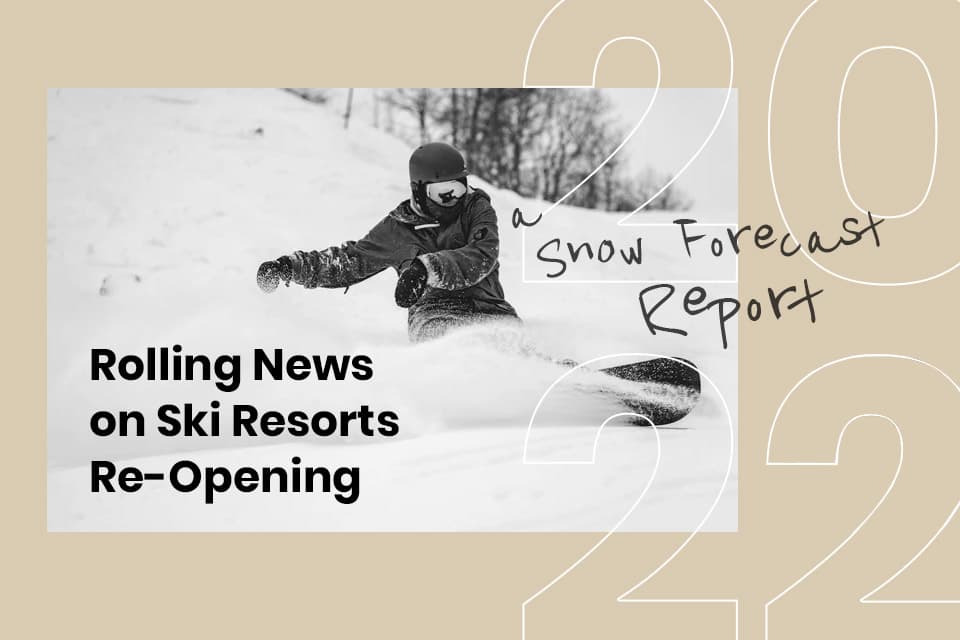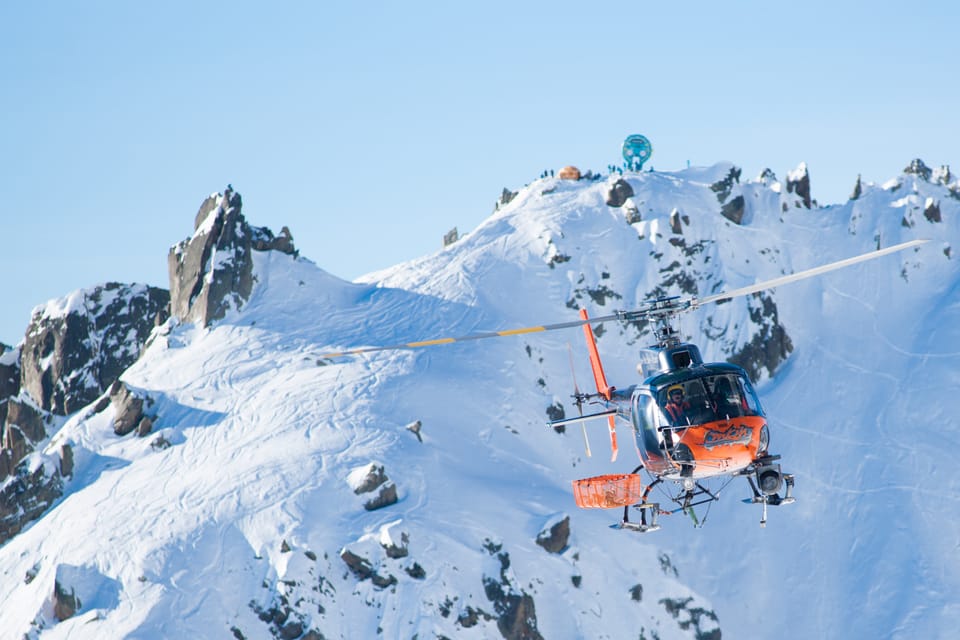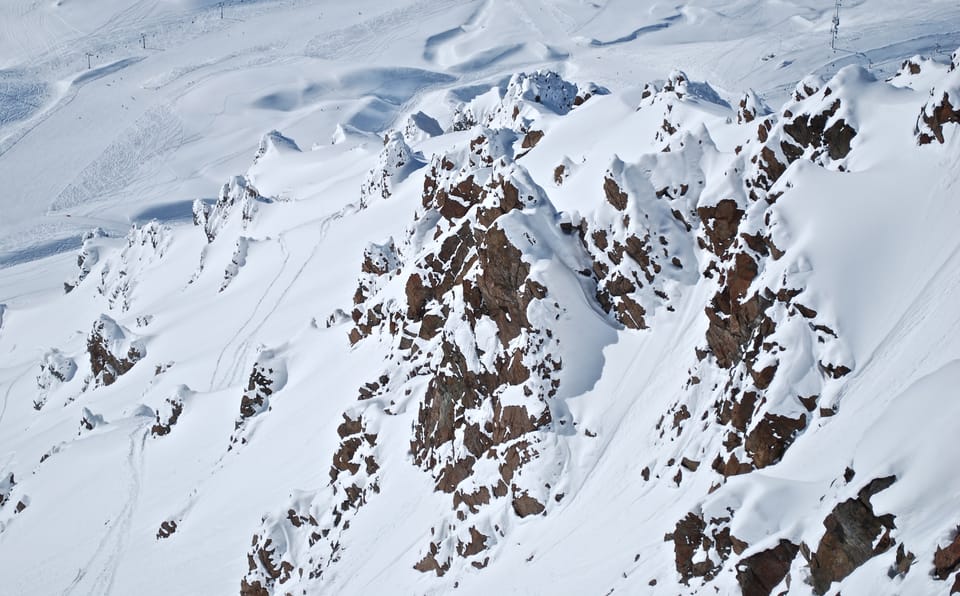South America’s Epic Snowfall Connects the Past & Future of Skiing

I peered out the window of the second-floor bar as the US Women’s Ski Team packed their gear in the parking area below. Mikaela, Jackie, Breezy, and others from the team and coaching staff shared some final laughs and a last look at the hotel before piling into the vans to take them to Santiago. The “storm of the decade” had just dumped eight feet of snow on Portillo the week before, and after a few days of good weather, another major storm cycle was moving into the Andes that would make training impossible for several days.
Meanwhile, free-skiers and powder hounds from around the world were arriving to the legendary Chilean resort to take advantage of the best snow the region had seen for over a decade. Portillo, and its unmistakable yellow hotel built in 1949, has famously been described as a cruise ship that crashed in the Andes mountains. And it felt as though everyone was battening down the hatches before being set adrift in a great white ocean as the US Ski Team descended the mountain pass, the military closing the road behind them. Those of us who stayed onboard marked our calendars for days ahead when the storm might clear, and blue skies and South American powder would make for one of the best ski days of our lives.
Until then, back-to-back days were mostly spent in the lodge, getting to know the hotel’s staff and playing boardgames or jigsaw puzzles with fellow guests as everyone naturally began to form friend groups like a wintery summer camp. And each morning, the view out my window from a bunkroom in the Inca Lodge became slimmer and slimmer with the growing snowbanks. Occasionally, when the visibility would improve enough for patrol to clear some of the avalanche danger, we’d escape for a few runs in the flat light, skiing into the void of a tree-less alpine landscape where you had to have blind faith in the consistency of the snow and pitch in front of you. And all through then, we kept an eye on the weather forecasts, which we knew were questionably reliable in the second highest mountain range in the world just seventy miles from the Pacific Ocean, hoping that the little ‘sun’ icon on Thursday, September 7th would come true.

And when the day arrived, our patience was greatly rewarded. The mountains began to glow as the sun penetrated the thinning cloud layer in the early morning. Then, as the last of the fog cleared away, Portillo emerged under bluebird skies coated in yet another layer of light powder, and not a speck of wind. Avy guns having done their work, ten of us lined up behind the bottom of the Plateau chair as we watched the last of the snow cats creep off the mountain. Then the ropes dropped.
What happened next I can only describe as probably the most epic ski day I’ve ever had. Not just for the quality of the snow, the weather, the terrain, but also because we could reap the goods run after run after run from open to close. I spontaneously linked up with a Chilean snowboarder I’d met in the hot tub the day before whose family has come to Portillo annually for decades. We ran laps from the open snowfields off the Condor sling-shot lift, to tight powder filled couloirs like Gargantita 1 and 2 that he’d never dropped into before after more than twenty seasons at the resort. Even my wife, an intermediate skier mostly limited to east coast groomers, had a blast wiping out every few turns as she tuned her powder skiing abilities. Despite patrol only being able to open a very limited portion of the terrain, fresh tracks were easily available in abundance throughout the day, made all the more accessible by the non-existent lift lines. I wondered how even more epic this mountain could be when the full extent of the valley was available. Still, surely Portillo turned out what must have been one of the best days in its history…right?
Even the most jaded skier couldn’t deny Thursday September 7th was an incredible day, and everyone knew it was the most snow Portillo had seen in over a decade. But my perspective changed when I had a conversation with Miguel, the general manager for over twenty years, on the final night of my stay. There in the lounge outside the main dining room, he explained to me that while the six meters of snow that had fallen this season was the most Portillo had seen since at least 2009, it was still shy of the seven to eight meters the ski area historically received. This wasn’t a record breaking season, in fact it wasn’t even average yet.

I spent six years of my 20’s in grad school getting a degree in marine and atmospheric sciences, and everywhere I travel I’m constantly thinking about the converging forces creating the climate around me. Portillo is a visceral case example of climate change, something that is often thought of as a looming threat in the future, but is very much present in the Andes. Knowledge like what Miguel was sharing helped me to better understand that. A long drought has persisted over the Chilean Andes for about fifteen years causing dwindling snow levels and lowering the level of the Lago de Inca that centers the view behind the hotel. A round peninsula that sticks out at the bottom of the famous Lake Run like a catcher’s mitt to save falling skiers who slide past the turnoff should actually be underwater. Lago de Inca itself hasn’t frozen over for at least ten years.
Even unexpected “big” winters like the one still hitting the Central and Southern Andes, and the US and Canadian Rockies last year, may – ironically – be connected to a warming but increasingly volatile planet. El Niño Southern Oscillation (ENSO), or just El Niño and La Niña, represent different phase shifts of strong and weak wind patterns over the Pacific Ocean respectively that can affect weather around the globe, including winters in both North and South America. Some places tend to win out, while others draw the short straw. The Central and Southern Andes are one of those places that tend to receive extra snowfall during El Niño’s, and the first one in several years officially set in this June. It has swiftly strengthened since likely giving snow accumulations in the region an extra shot in the arm, and could strengthen enough by December to contend for the most extreme El Niño event in over 50 years. Climate change is expected to cause fewer but more extreme El Niño and La Niña patterns overtime. That could mean more big snows some years, but also more intense and longer snow droughts in-between.
But the only constant is more uncertainty. While the Andes might be experiencing an “average” winter in terms of total snowfall, this one’s been unprecedented because most of it has fallen at the tail end of the season. I was frequently told by Miguel and others that this was the most snow ever seen in September, making the mountain look more like July and August of yesteryear. So combination of the heavy snow and its unlikely timing are reflective of the type of crazy weather events that the ski industry will increasingly face in the years to come. Snow is great whenever we can get it, but the increasing unpredictability is a burden on ski mountain management.

Still, as I observed this historic blizzard rage on above me (from the safety of an outdoor hot tub with a drink in my hand), I couldn’t help but be amazed that what I was witnessing was in part fueled by and also connected to equally extreme events simultaneously happening around the world as this year’s El Niño sets in. Amazed, however, in the way that an avalanche is incredible to witness, yet unnerving and potentially dangerous if you’re standing in the wrong place. For example, as a marine biologist, I kept thinking how the snow I was enjoying was in part connected to marine heatwaves around the world also triggered by the El Niño. Back home in Colombia, coral bleaching from the warmer water has already been observed this year on both the Caribbean and Pacific coasts, and could continue to imperil coral reefs worldwide. South America’s snowfall is one part of a much larger global event.
—
Now it’s not my intention to damper the mood by marring this incredible experience with a bunch of negative thoughts and facts. We should enjoy fantastic skiing whenever and wherever we can. But it’s also important to come to terms with how climate change can endanger our sport, and places like Portillo and awesome winters like the one South America is experiencing play an important role in changing that future for the better.
How’s that? Take a phenomenon in ocean conservation called “Shifting Baselines”. To sum it up, our reference points for what’s “normal” in the environment are often biased towards however things were when we were young or just learning about a given subject. So as the environment changes with time, so does our collective perception on what a healthy environment is supposed to look like with each subsequent generation. This can put efforts to protect and restore natural systems in trouble because incorrect perceptions on how many fish should be in the ocean or how much it should snow in a given year can cloud the true extent of the damage already done.

Making for a better planet requires complete knowledge on how things have and are changing so that we can set a correct course to remedy those issues in the future. Things like the lack of ice on Lago de Inca, the elevation of the rain/snow line that creeps higher up road towards Portillo’s base lodge over the years, or low snow years that make once average winters seem exceptional…these are becoming Portillo’s new “normal”. And you’ve probably been to a ski area yourself that’s experienced something similar. We can’t let that happen and have to make sure that knowledge from previous generations of skiers and riders is shared with others like Miguel was sharing with to me. Story telling isn’t just for fun, it can play a valuable role in science and advocacy as we seek to put a picture of the past together like the jigsaw puzzle I was working on in the lodge.
Fortunately, storytelling and time preservation is something Portillo fosters naturally as a time capsule that seems to exude every era of skiing at once. By day, the old-world charm of the hotel feels as though a 25 year old Jean-Claude Killy could be in a turtle neck sitting by the fire, or that James Bond might stroll into the lobby with his Union Jack parachute over his shoulder and check into a hotel suite moments after skiBASE-ing off the cliffs above. At night the vibe turns 80’s ski movie, complete with guest-instructor-band dance parties, ski rivalries, and romantic drama (though the shot-ski has been officially banished to the basement where we found it hiding). And the modest technology and few lift lines are reminiscent of a time when skiing was less commercialized.
But this season’s snowfall has been a particularly special portal to the past. On my final day, as I enjoyed one last hour in the lodge before boarding the shuttle to leave, I saw a group up above lining up to drop into the Española Couloir, which opened for the first time in at least a decade. One instructor told me he also skied a line that even his most senior colleagues didn’t know the name to, and perhaps had never been done before. Or, I wondered, perhaps it had been so many years since the line was skiable that its name had long been forgotten.

Indeed, the lucky few who have been privileged to ski in the Southern Andes this September have had a chance to connect with prior generations of skiers and riders in a way that’s increasingly rare. For a few amazing days, we could experience firsthand the benefits of winters as they used to be, and the anxiety of a future with warmer winters and less snow were temporarily assuaged as we made the most of every turn. The question lingering in my mind now is, having witnessed something so rare and special, what will we do with the knowledge, energy and excitement we’ve been given when we return home?
A bit of self reflection is a good place to start. With plane flights, snow guns, helicopters, chairlifts, or just heating a building at 10,000 feet through the winter, skiing is not what you would call a low impact sport and the industry has a responsibility to itself and the planet at large to do its best to be more sustainable. Portillo is helping set an example by attempting to achieve carbon neutrality, which is a tall task considering its location and the age of its infrastructure, but they are getting there. Miguel explained to me that the hotel draws from 100% renewable energy from solar farms in the north, and they’ve upgraded snow making equipment to high efficiency guns. Many other resorts around the world are making similar changes, and organizations like Save our Snow have arisen as great resources on the impacts of climate change on the ski industry by showcasing which areas are making environmentally friendly changes that can help skiers and riders like you make more informed choices. If you don’t see your favorite hill taking steps to lessen their environmental impact, raise your voice!
Then there’s looking outwardly and thinking about skiing’s place in larger conversations. It’s important for the ski and ride community to remember that, from glaciers to coral reefs, a warming planet affects us all. There are other resources and communities beyond the ski industry that are important to get involved with that can be mutually beneficial. And in turn, that by having a major stake in climate change outcomes, that the industry as the potential to carve a seat for itself in larger climate change discussions. Initiatives like Protect our Winters have helped grow a massive coalition of concerned athletes that have become a powerful advocacy tool for climate action. But more is needed. Climate Week which just concluded in New York, and the 28th UN Climate Change Conference will be in Dubai in December…right when the current El Niño might be peaking. These types of gatherings are opportunities for individuals and companies within the ski industry to take action and build representation from the community.
—
I left Portillo with a deeper understanding of the extent climate change is already impacting our world, but also with a greater appreciation of how much there still is to protect. Maybe it was the young budding racer who smiled ear to ear as she ran through the hotel having just gotten a photo with her idol Mikaela Shiffrin, who returned to Portillo along with the rest of the women’s speed team that afternoon. Maybe it was the more than six Andean Condors, an endangered species and cultural symbol of the Andes, that I saw soaring over the van as we descended the switchbacks just a few minutes later. But despite all the uncertainty in the world, including around this sport, I felt optimistic about the future of skiing and the planet at large. Future generations will carry on the sport no matter what, we’re a passionate bunch after all. But we have a chance to decide what the future of the sport will look like. Will future skiers only have stories to tell of winters past, or will they be able to experience them for themselves?
After extending their season a week for the late season snow, Portillo’s 2023 season finally came to an end last Sunday, October 1st. Whether you had a chance to experience the South American snowfall first hand or you’ve watched posts about it on social media with envy, my hope is that the South American ski season of 2023 is forever remembered as a symbol of how climate change is already impacting our sport, but also how amazing it can still be and a source of inspiration for environmental action and building a better future for generations of skiers and riders to come.
About the author: Johnny Bohorquez is a marine biologist, 3rd generation Sugarloafer, and founding member of the Bowdoin Alpine Ski Team. He lives in Medellín, Colombia where he is attempting to pick up whitewater kayaking.




